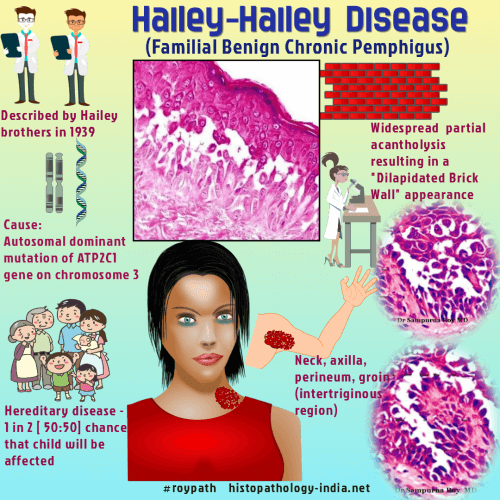|

Custom Search
|
|
Dermpath-India Pathology of Hailey-Hailey Disease Dr Sampurna Roy MD 2022
|

 |
Hailey-Hailey disease (familial benign chronic pemphigus) is an autosomal dominant disorder with recurrent eruption of vesicles and bullae. It was originally described by the Hailey brothers in 1939. The lesion is caused by mutations in the ATP2C1 gene encoding a novel Ca(2+) pump. The blistering dermatitis is characterized by acantholytic cells present in foci throughout at least half of the thickness of the epidermis. Site: Predominantly involve the neck, groin, inframammary, perianal and axillary regions. Rarely oral, ocular, esophageal and vaginal cases have been reported. Age: Usually occurs in the second or third decade of life. Clinical presentation: Usually presents as well demarcated plaques. Rare variants: Papular, annular, verrucous, and vesiculopustular variants. Course: This chronic disease is characterized by spontaneous remission with subsequent exacerbation.
Differential diagnosis: Hailey-Hailey variant of Grover's disease: Narrow vesicle involving not more than a few rete ridges. Hailey-Hailey disease is more florid. Example: More confluence, more markedly thickened epidermis, more acantholytic cells, more dyskeratotic cells with polygonal outlines, more vesiculation, and more scale-crusts. Pemphigus vulgaris: Less acantholysis and acantholytic cells are confined to the suprabasal region; Some cells show more prominent dyskeratosis ; Epidermis of relatively normal thickness ; Infundibular epidermis & epithelial structures of adnexa are involved by the process; There are no scale-crusts.
|
|
|
 |



